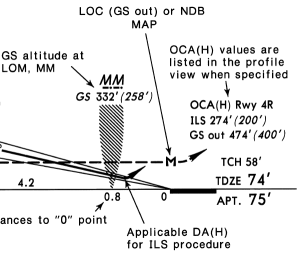
The M.A.P. Study Guide is a list of notes I first developed during instrument-flight-instructor training because I needed a concise explanation of various approach profiles. Now that I’m considering airline jobs, I’ve decided to adapt my study guide to the chart format used by Jeppesen, which is also used by many airlines. I find the missed approach procedures slightly more intuitive in the Jeppesen format, but it also presents more information that can become overwhelming at first.
![]() Study Guide Download – Jepp Format (1.2 MB)
Study Guide Download – Jepp Format (1.2 MB)
You might also want the FAA charts format of the study guide.
Introduction
Reading a missed approach procedure is a critical step toward briefing and flying a complete instrument approach to an airport. The missed approach point is the position where the pilot must immediately climb away from the airport if the landing criteria of FAR 91.175(c) are not met. There are two challenges involved in reading the missed approach point:
Location
Where is the missed approach point? The profile view depicts the missed approach point as a block M symbol or as a pull-up arrow, as shown above. A text description also appears in the time and speed table below the profile view. Missed approach points are generally located between the final approach fix and the airport. Each procedure may have two or three different missed approach points. Common locations for a missed approach point include the runway threshold, the primary NAVAID for the approach, and the intersection of the glide slope with the decision altitude.
Identification
How does the pilot know when the aircraft has reached the missed approach point? The pilot must understand the aircraft position relative to the missed approach point while flying each instrument approach procedure. Because each procedure has a unique configuration, the indications and techniques used to identify the missed approach point may be unique as well. Common identifiers for a missed approach point include a named waypoint, a DME fix, and a time and speed table.
This study guide contains several scenarios that illustrate the most common types of instrument approach configurations. These can be used as examples for learning to read and identify the location of a missed approach point.
Scenario #1: ILS Approach
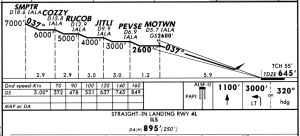
On an ILS, the missed approach point is that point at which the glide slope intersects the Decision Altitude (DA).
In this example, the climb to 1,100 ft is initiated upon reaching 895 ft and deciding to go missed.
In case of an early missed approach, the pilot would rely on DME or RADAR to approximate crossing the missed approach point before making the left turn.
Scenario #2: NDB Approach without DME
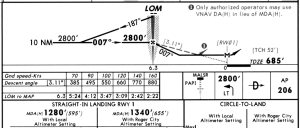
On the example NDB, the missed approach point can be identified only by flying a timed leg using a clock. The climb to 2,800 ft is initiated when the final approach time expires, and the left turn can be made at or beyond that point. In general, it is “inadvisable or impossible” to execute a normal landing from the missed approach point of a non-precision approach procedure. The missed approach point is the same for straight-in and circling approaches.
In case of an early missed approach, the pilot would maintain the approach speed and cross the missed approach point before making the left turn.
The profile for an NDB approach is essentially identical to VOR and LOC approaches. The most common difference is that NDB approaches usually do not have DME service, whereas VOR and LOC approaches almost always offer DME.
A runway fix is sometimes depicted at the missed approach point, as in the KDET NDB RWY 15. This might serve as a quasi-DME for GPS equipped pilots.
Scenario #3: LOC Approach with DME
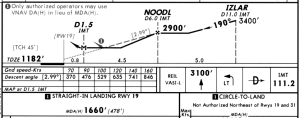
On the example LOC, the missed approach point is 1.5 DME from the IMT VOR/DME. The climb to 3,100 ft is initiated at or before 1.5 DME, and the left turn can be made at or beyond 1.5 DME. In general, it is “inadvisable or impossible” to execute a normal landing from the missed approach point of a non-precision approach procedure (the descent angle from 1.5 DME in this example would be 5.6 degrees). The missed approach point is the same for straight-in and circling approaches.
To use DME in identifying the missed approach point, the DME number must be published in the procedure, which is not always the case.
Scenario #4: ILS or LOC Approach with DME
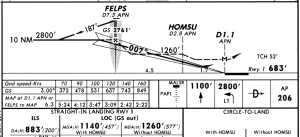
On an ILS, the missed approach point is that point at which the glide slope intersects the Decision Altitude (DA). This is depicted by the glide slope “pull-up arrow” in profile view.
On the example LOC, the missed approach point is 1.1 DME from the APN VORTAC. The climb to 1,100 ft is initiated at or before 1.1 DME, and the left turn can be made at or beyond 1.1 DME. In general, it is “inadvisable or impossible” to execute a normal landing from the missed approach point of a non-precision approach procedure. If not equipped with DME or a GPS substitute, the missed approach point can be identified by flying a timed leg using a clock. The missed approach point is the same for straight-in and circling approaches, but is different from the ILS. The missed approach course for straight-in LOC or circling is depicted by the block M symbol in profile view.
A common mistake when briefing this type of procedure is to state that the missed approach point is 6.3 NM from the final approach fix, which is depicted two different ways in the profile view and the time and speed table. The correct way to identify the missed approach point is by using 1.1 DME, which is 6.2 DME beyond the final approach fix. Notice they are not the same numbers.
This type of approach is named LDA if not aligned within 3° of the runway centerline.
Scenario #5: ILS or LOC Approach without DME
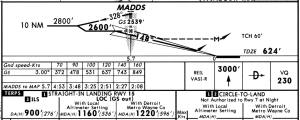
On an ILS, the missed approach point is that point at which the glide slope intersects the Decision Altitude (DA). This is depicted by the glide slope “pull-up arrow” in profile view.
In case of an early missed approach, no turns are allowed prior to reaching the CARGL NDB (VQ).
On the example LOC, the missed approach point can be identified only by flying a timed leg using a clock. The missed approach point is the same for straight-in and circling approaches, but is different from the ILS. The missed approach course for straight-in LOC or circling is depicted by the block M symbol in profile view.
Scenario #6: VOR Approach with Incomplete DME Information
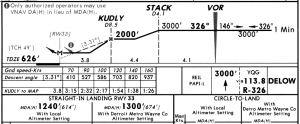
On the example VOR, the missed approach point can be identified only by flying a timed leg using a clock. The climb to 3,000 ft is initiated when the final approach time expires. In general, it is “inadvisable or impossible” to execute a normal landing from the missed approach point of a non-precision approach procedure. The missed approach point is the same for straight-in and circling approaches.
Also note this procedure requires a descent angle greater than 3 degrees.
A common mistake when briefing this type of procedure is to state that the missed approach point is 3.8 NM from the final approach fix, or 12.3 DME. The correct way to identify the missed approach point is by using the times depicted below the profile view. Notice the missed approach point DME is not depicted. In this example, DME is used only to identify the top of descent fix and the final approach fix.
Scenario #7: VOR at the Airport
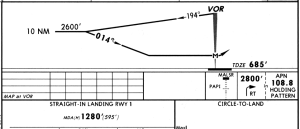
On the example VOR, the missed approach point is identified when the VOR direction flag changes to the FROM indication. The climb to 2,800 ft is initiated at or before the VOR, and the right turn can be made at or beyond the VOR.
Similarly, on an NDB approach, the ADF needle would indicate passing the NDB.
Scenario #8: RNAV without VNAV
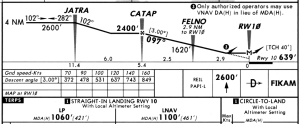
On an LNAV, the missed approach point is the last waypoint in the profile view, and is depicted by a block M symbol.
In case of an early missed approach, no turns are allowed prior to reaching the FIKAM waypoint.
LP is a slightly more precise RNAV guidance level provided by WAAS. The missed approach point is the same for LP, LNAV, and circling approaches.
Scenario #9: RNAV with VNAV
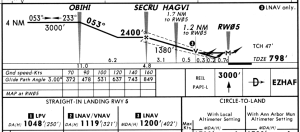
On an LPV or LNAV/VNAV, the missed approach point is that point at which the glide slope intersects the Decision Altitude (DA). In this example, there are two different DAs. These missed approach points are each depicted by a glide slope “pull-up arrow.” The missed approach point for LNAV and circling minimums is depicted by the block M symbol in profile view.
In case of an early missed approach, no turns are allowed prior to reaching the EZHAF waypoint.
On an LNAV, the missed approach point is the last waypoint depicted in the profile view (RW05). In this example, it is difficult to distinguish between the missed approach point and the visual descent point (VDP). A pilot would initiate the climb to 3,000 ft between the VDP and RW05. Since no turns are allowed and by definition it is impossible to make a normal landing beyond the VDP, there is no reason to wait for RW05.
The missed approach point is the same for LNAV and circling approaches, but is different from the LPV and LNAV/VNAV. In other words, the example procedure has three different missed approach points.
Scenario #10: LOC/VOR Approach
This is a technicality mentioned in the FAA handbooks. A missed approach point might be defined by a cross-radial from a second NAVAID, and identified during the approach using a second receiver. However, this is extremely rare and I have yet to find any example of this in a non-military procedure. Cross radials are more commonly used to identify a final approach fix. Reference KNFW ILS or LOC RWY 17.
Scenario #11: LOC/DME with RNAV Substitution
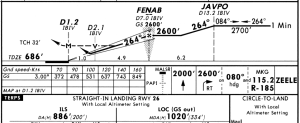
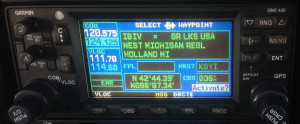
LOC/DME procedures rarely include timed legs or a named fix or intersection to identify the missed approach point. On the example LOC, the missed approach point may be identified only by using DME. Because general aviation aircraft are increasingly dependent on GPS distance information and may not have DME transceivers, the pilot must determine whether the avionics are “suitable” for this procedure. This includes procedures titled “ILS or LOC/DME” which are relatively common. RNAV substitution for the DME is allowed per AC 90-108 to “determine aircraft position relative to or distance from a … DME fix.” Notice it also says, “Pilots must extract waypoints, NAVAIDs, and fixes by name.”
RNAV equipment may be capable of displaying the distance to IBIV, for example, by using the “Direct To” feature of a GNS 430 receiver. The attached photo of a GNS 430 receiver shows that the IBIV facility can be identified by name. The small blue square symbol next to IBIV indicates this is a DME facility. However, that same receiver is unable to load the 1.2 DME fix as part of an approach procedure. As described in AIM 1‑1‑18(n)(11), “a DME fix will not be in the waypoint sequence on the GPS receiver unless there is a published name assigned to it.”
Scenario #12: ASR Approach
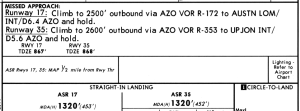
Jeppesen charts include a separate plate for ASR procedures at each airport. The location of the missed approach point is published for approaches that have straight-in minimums, but there is no profile view. ASR approach procedures by their nature assume the pilot may have no functioning navigation equipment.
RADAR identification of the missed approach point is provided for ASR approach procedures. Air Traffic Control uses the following phrase to specify the location:
Missed approach point is (distance) miles from the runway.
During the approach, ATC uses this phrase to identify the point:
Over missed approach point. If runway not in sight, execute missed approach.
Scenario #13: PAR Approach
On a PAR procedure, the missed approach point is the intersection of the PAR glide path and a published decision altitude. The terms Decision Altitude (DA) and Decision Height (DH) have the same meaning in this case, and both are MSL altitudes. RADAR identification of the missed approach point is provided using the following phrase:
At decision height.
Scenario #14: Unusual Approaches
This study guide does not describe all real world situations. There are exotic procedures involving mountainous terrain, restricted airspace, Cat II & III, SDF, IGS, RNP, PRM, and many others. It is always the pilot’s responsibility to understand the procedure before attempting it.
Jeppesen chart excerpts displayed for nonprofit educational purposes only.
2 responses to “Missed Approach Points in Jeppesen Charts”
Excellent explanation. Much appreciated. Thanks
This is great information to review. Too bad i didn’t find this website before I had a telephone interview today. Many gotcha questions, that after 47 years of flying, you tend to forget the “specifics”, but know how to accomplish the procedures with years of repetition in 121 operations. This FAR part 91/135 operator of SEL aircraft had their basic first round questions which caught me off guard, and had I known I would have reviewed far part 91/135 regs..I guess 7 wrong out of 13 wasn’t good enough! The interviewer was looking for one or 2 word answers specific to many questions. For instance a question with respect to an ODP, in my world this is covered by a SID. After I failed his 13 question test, I asked what was an ODP and I thought he replied Optical Departure Procedure, however, he had meant Obstacle Departure Procedure.. Had I reviewed these specifics ahead of time, I would have gotten 4 or 5 more questions correctly.